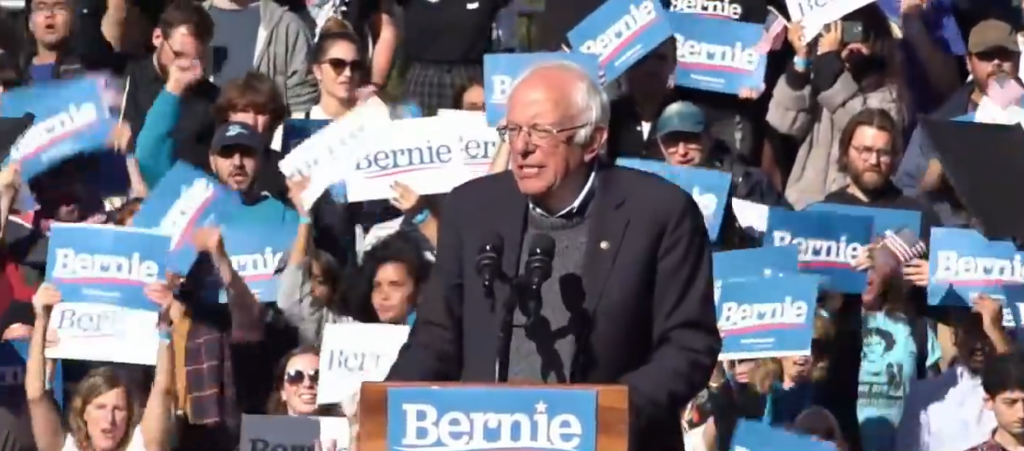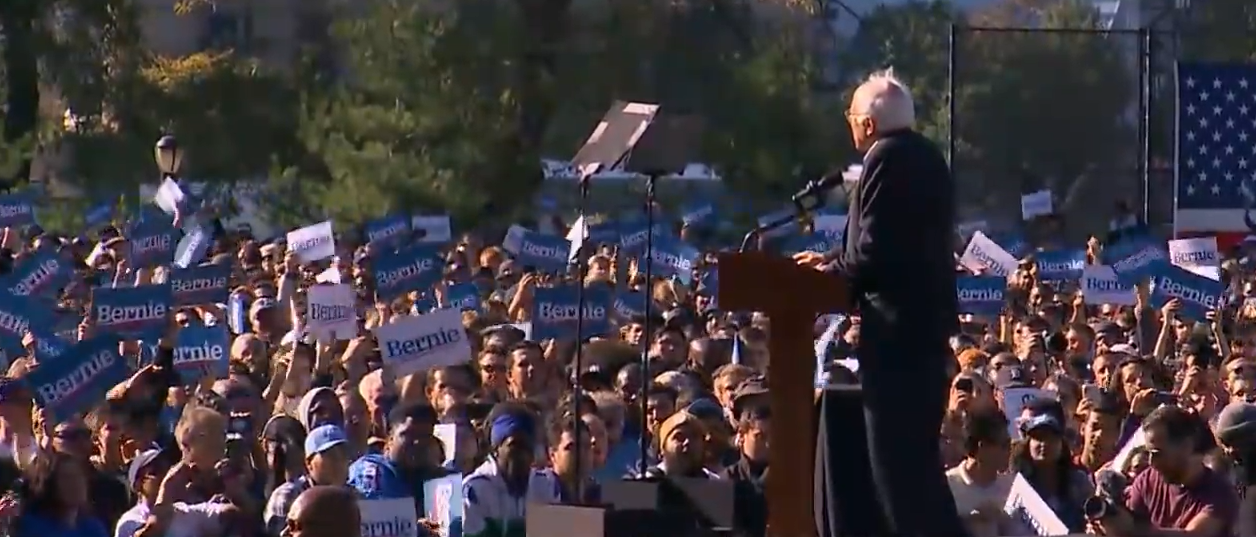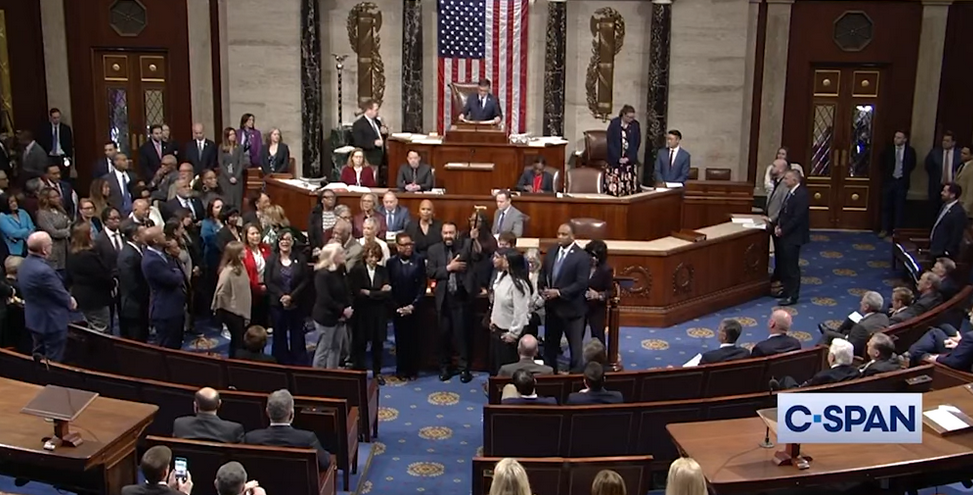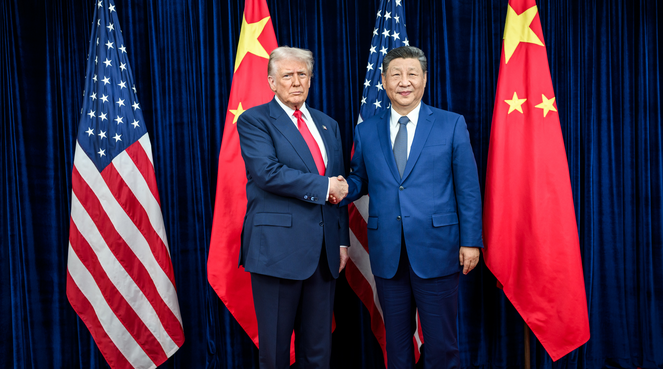By Krystal Ball
Photos: YouTube Screenshots
There are a million surface-level reasons for Kamala Harris’s loss and systematic underperformance in pretty much every county and among nearly every demographic group. She is part of a deeply unpopular administration. Voters believe the economy is bad and that the country is on the wrong track. She is a woman and we still have some work to do as a nation to overcome long-held biases.
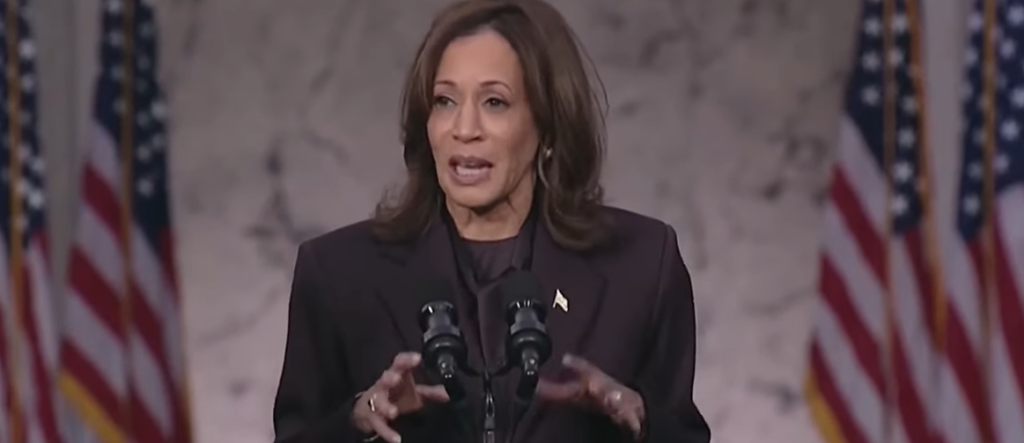
But the real problems for the Democrats go much deeper and require a dramatic course correction of a sort that, I suspect, Democrats are unlikely to embark upon. The bottom line is this: Democrats are still trying to run a neoliberal campaign in a post-neoliberal era. In other words, 2016 Bernie was right.
Let’s think a little bit about how we got here. The combination of the Iraq War and the housing collapse exposed the failures and rot that were the inevitable result of letting the needs of capital predominate over the needs of human beings. The neoliberal ideology which was haltingly introduced by Jimmy Carter, embraced fully by Ronald Reagan, and solidified across both parties with Bill Clinton embraced a laissez-faire market logic that would supplant market will for national will or human rights, but also raise incomes enough overall and create enough dynamism that the other problems were in theory, worth the trade off. Clinton after all ran with Reagan era tax cutting, social safety net slashing and free trade radicalism with NAFTA being the most prominent example.
Ultimately, of course, this strategy fueled extreme wealth inequality. But for a while this logic seemed to be working out. The Soviet Union collapsed and the Cold War ended. Incomes did indeed rise and the internet fueled tech advances contributing to a sense of cosmopolitan dynamism. America had a swaggering confidence that these events really did represent a sort of end of history. We believed that our brand of privatization, capitalism, and liberal democracy would take over the world. We confidently wielded institutions like the World Bank, IMF, and WTO to realize this global vision. We gave China most-favored nation trade status.
Underneath the surface, the unchecked market forces we had unleashed were devastating communities in the industrial Midwest and across the country. By the neoliberal definition NAFTA was a roaring success contributing to GDP growth. But if your job was shipped overseas and your town was shoved into economic oblivion, the tradeoff didn’t seem like such a great deal.
The underlying forces of destruction came to a head with two major catastrophes, the Iraq War and the housing collapse/Great Recession. The lie that fueled the Iraq war destroyed confidence in the institutions that were the bedrock of this neoliberal order and in the idea that the U.S. could or should remake the world in our image. Even more devastating, the financial crisis left home owners destitute while banks were bailed out, revealing that there was something deeply unjust in a system that placed capital over people. How could it be that the greedy villains who triggered a global economic calamity were made whole while regular people were left to wither on the vine?
These events sparked social movements on both the right and the left. The Tea Party churned out populist-sounding politicians like Sarah Palin and birtherist conspiracies about Barack Obama, paving the way for the rise of Donald Trump. The Tea Party and Trumpism are not identical, of course, but they share a cast of villains: The corrupt bureaucrats or deep state. The immigrants supposedly changing your community. The cultural elites telling you your beliefs are toxic. Trump’s version of this program is also explicitly authoritarian. This authoritarianism is a feature not a bug for some portion of the Trump coalition which has been persuaded that democracy left to its own devices could pose an existential threat to their way of life.
On the left, the organic response to the financial crisis was Occupy Wall Street, which directly fueled the Bernie Sanders movement. Here, too, the villains were clear. In the language of Occupy it was the 1% or as Bernie put it the millionaires and billionaires. It was the economic elite and unfettered capitalism that had made it so hard to get by. Turning homes into assets of financial speculation. Wildly profiteering off of every element of our healthcare system. Busting unions so that working people had no collective power. This movement was, in contrast to the right, was explicitly pro-democracy, with a foundational view that in a contest between the 99% and the 1%, the 99% would prevail. And that a win would lead to universal programs like Medicare for All, free college, workplace democracy, and a significant hike in the minimum wage.
These two movements traveled on separate tracks within their respective party alliances and met wildly different fates. On the Republican side, Donald Trump emerged as a political juggernaut at a time when the party was devastated and rudderless, having lost to Obama twice in a row. This weakened state—and the fact that the Trump alternatives were uncharismatic drips like Jeb Bush—created a path for Trump to successfully execute a hostile takeover of the party.
Plus, right-wing populism embraces capital, and so it posed no real threat to the monied interests that are so influential within the party structures. The uber-rich are not among the villains of the populist right (see: Elon Musk, Bill Ackman, and so on), except in so much as they overlap with cultural leftism. The Republican donor class was not thrilled with Trump’s chaos and lack of decorum but they did not view him as an existential threat to their class interests. This comfort with him was affirmed after he cut their taxes and prioritized union busting and deregulation in his first term in office.
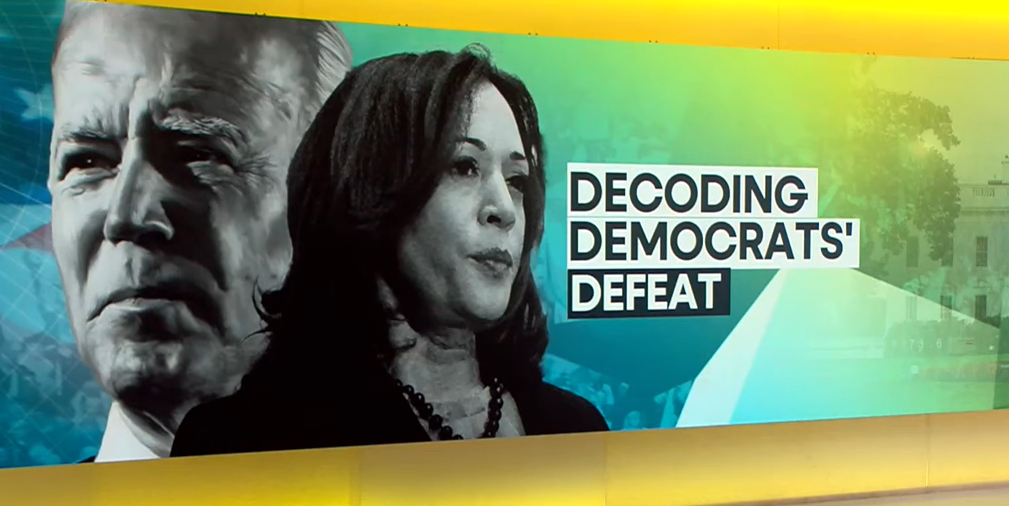
Meanwhile, the Democratic Party put its thumb on the scales and marshaled every bit of power they could, legitimate and illegitimate, to block Bernie Sanders from a similar party takeover. The difference was that Bernie’s party takeover did pose an existential threat—both to party elites who he openly antagonized and to the party’s big money backers. The bottom line of the Wall Street financiers and corporate titans was explicitly threatened. His rise would simply not be allowed. Not in 2016 and not in 2020.
What’s more, Hillary Clinton and her allies launched a propaganda campaign to posture as if they were actually to the left of Bernie by labeling him and his supporters sexist and racist for centering class politics over identity politics. This in turn spawned a hell cycle of woke word-policing and demographic slicing and dicing and antagonism towards working class whites that only made the Democratic party more repugnant to basically everyone.
This identity politics sword has also been wielded within the Democratic Party to crush any possibility of a Bernie-inspired class focused movement in Congress attempted by the Justice Democrats and the Squad in 2018. My colleague Ryan Grim has written an entire book on this subject so I won’t belabor the point here. But suffice it to say, the threat of the Squad to the Democratic Party’s ideology and order has been thoroughly neutralized. The Squad members themselves, perhaps out of ideology and perhaps out of fear of being smeared as racist, leaned into identitarian politics which rendered them non-threatening in terms of national popular appeal. They were also relentlessly attacked from within the party, predominately by pro-Israel groups that an unprecedented tens of millions of dollars in House primaries, which has led to the defeat of several members and has served as a warning and threat to the rest.
That brings us to today where the Democratic Party stands in the ashes of a Republican landslide which will sweep Donald Trump back into the White House. The path not taken in 2016 looms larger than ever. Bernie’s coalition was filled with the exact type of voters who are now flocking to Donald Trump: Working class voters of all races, young people, and, critically, the much-derided bros. The top contributors to Bernie’s campaign often held jobs at places like Amazon and Walmart. The unions loved him. And—never forget—he earned the coveted Joe Rogan endorsement that Trump also received the day before the election this year. It turns out, the Bernie-to-Trump pipeline is real! While that has always been used as an epithet to smear Bernie and his movement, with the implication that social democracy is just a cover for or gateway drug to right wing authoritarianism, the truth is that this pipeline speaks to the power and appeal of Bernie’s vision as an effective antidote to Trumpism. When these voters had a choice between Trump and Bernie, they chose Bernie. For many of them now that the choice is between Trump and the dried out husk of neoliberalism, they’re going Trump.
I have always believed that Bernie would have defeated Trump in 2016, though of course there is no way to know for sure. What we can say for sure is that the brand of class-first social democracy Bernie ran on in 2016 has proven successful in other countries because of course the crisis of neoliberalism is a global phenomenon. Most notably, Bernie’s basic political ideology was wildly successful electorally with Andrés Manuel López Obrador and now his successor Claudia Sheinbaum in Mexico, Lula Da Silva in Brazil, and Evo Morales in Bolivia. AMLO, in fact, was one of the most popular leaders in the entire world and dramatically improved the livelihoods of a majority of his countrymen. Bernie’s basic ideology was also successful in our own history.
In the end, I got this election dead wrong. I thought between January 6th and the roll back of human rights for women, it would be enough. I thought that the overtly fascist tendencies of Donald Trump and the spectacle of the world’s richest man bankrolling him would be enough strikes against him to overcome the problems of the Democratic Party which I have spoken out about for years now–problems Kamala Harris decided to lean into rather than confront. Elevating Liz Cheney as a top surrogate was not just a slap in the face to all the victims of American imperialism—past and ongoing; it was a broad signal to voters that Democrats were the party of elites, playing directly into right-wing populist tropes. While the media talked about it as a “tack to the center,” author and organizer Jonathan Smucker more aptly described it as “a tack to the top.” And as I write this now, I have zero hope or expectation that Democrats will look at the Bernie bro coalition and realize why they screwed up. Cable news pundits are already blaming the left once again for the failures of a party that has little to do with the actual left and certainly not the populist left.
Instead, Trump’s victory represents a defeat of social democratic class-first politics in America—not quite final, but not temporary either. The Democrats have successfully smothered the movement, blocked the entranceways, salted the earth. Instead they will, as Bill Clinton did in the ‘90s, embrace the fundamental tenets of the Trumpist worldview.
They already are, in fact. Democrats have dropped their resistance to Trump’s mass deportation policies and immigrant scapegoating. The most ambitious politician in the Democratic coalition, Gavin Newsom, is making a big show of being tough-on-crime and dehumanizing the homeless. Democrat-leaning billionaires like Jeff Bezos who not only owns Amazon but the Washington Post have already abandoned their resistance.
Maybe I will be just as wrong as I was about the election but it is my sense that with this Trump victory, authoritarian right politics have won the ideological battle for what will replace the neoliberal order in America. And yes, I think it will be ugly, mean, and harmful—because it already is.
